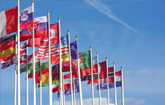Progress In Access To Safe Drinking-Water; Sanitation Needs Greater Efforts
Open defecation – the riskiest sanitation practice – is on the decline worldwide
GENEVA and NEW YORK, March 15 /PRNewswire-USNewswire/ -- With 87 percent of the world's population or approximately 5.9 billion people using safe drinking-water sources, the world is on track to meet or even exceed the drinking-water target of the Millennium Development Goals (MDG), according to the new WHO/UNICEF Joint Monitoring Programme (JMP) report titled: "Progress on Sanitation and Drinking - Water: 2010 Update Report," released today.
However, with almost 39 percent of the world's population or over 2.6 billion people living without improved sanitation facilities, the report also points out that much more needs to be done to come close to the sanitation MDG target. If the current trend continues unchanged, the international community will miss the 2015 sanitation MDG by almost one billion people.
The good news is that open defecation -- the riskiest sanitation practice of all -- is on the decline worldwide, with a global decrease from 25 percent in 1990 to 17 per cent in 2008, representing a decrease of 168 million people practicing open defecation since 1990. However, this practice is still widespread in Southern Asia, where an estimated 44 percent of the population defecate in the open.
The JMP report presents the current status and trends in 209 countries or territories towards reaching the drinking-water and sanitation MDG target, along with an assessment as to what these trends reveal.
"We all recognize the vital importance of water and sanitation to human health and well-being and their role as an engine of development. The question now lies in how to accelerate progress towards achieving the MDG targets and most importantly how to leap a step further to ultimately achieve the vision of universal access," said Dr Maria Neira, WHO's Director for the Department of Public Health and Environment.
This report provides the clearest picture to date of the current use of improved sanitation facilities and improved sources of drinking water throughout the world. The report is aimed to be used by policy-makers, donors, governmental and nongovernmental agencies to decide what needs to be done and where to focus their efforts to achieve these goals.
"We need to not only focus on reaching the water and sanitation MDG targets but also on achieving them with equity, ensuring that the most vulnerable groups and those hard to reach share in the successes achieved elsewhere," said Dr. Tessa Wardlaw, UNICEF's Chief of Statistics and Monitoring.
Despite the world's population being almost equally divided between urban and rural dwellers, the vast majority without access to water and sanitation live in rural areas. Seven out of ten people without basic sanitation are rural inhabitants and more than eight out of ten people without access to improved drinking-water sources live in rural areas.
A similar disparity is found between the poor and non-poor. A comparison between the richest and poorest 20 percent of the population in sub-Saharan Africa reveals that the richest are more than twice as likely to use an improved drinking-water source and almost five times more likely to use improved sanitation facilities. Although there is insufficient data at present, country data available confirms similar disparities elsewhere.
"With only five more years to go until 2015, a major leap in efforts and investments in sanitation is needed today in order to have an impact by the time we carry out our end-of-MDG evaluation," said Robert Bos, Coordinator, Water, Sanitation, Hygiene and Health at WHO.
Unsafe water, sanitation and hygiene claim the lives of an estimated 1.5 million children under the age of five each year. Lack of access to water, sanitation and hygiene affects the health, security, livelihood and quality of life for children, impacting women and girls first and most. They are much more likely than men and boys to be the ones burdened with collecting drinking-water.
"With almost 884 million people living without access to safe drinking-water and approximately three times that number lacking basic sanitation we must act now as one global community to ensure water and sanitation for all," said Ms. Clarissa Brocklehurst, UNICEF Chief of the Water, Sanitation and Hygiene (WASH).
About the JMP
The WHO/UNICEF Joint Monitoring Programme for Water Supply and Sanitation is the official UN mechanism tasked with monitoring progress towards MDG Target 7c on drinking-water supply and sanitation. The report includes information from household surveys and censuses completed during the period 1985–2008. A record number of nearly 300 datasets were added to the global database for this year's report. Importantly, the newer data have not yet registered the impact of the International Year of Sanitation (2008), which it is hoped will make a significant difference to the rate of progress towards the MDG sanitation target.
About WHO
WHO is the directing and coordinating authority for health within the United Nations system. It is responsible for providing leadership on global health matters, shaping the health research agenda, setting norms and standards, articulating evidence-based policy options, providing technical support to countries and monitoring and assessing health trends. WHO has recognized the importance of water and sanitation from its inception.
About UNICEF
UNICEF is on the ground in over 150 countries and territories to help children survive and thrive, from early childhood through adolescence. The world's largest provider of vaccines for developing countries, UNICEF supports child health and nutrition, good water and sanitation, quality basic education for all boys and girls, and the protection of children from violence, exploitation, and AIDS. UNICEF is funded entirely by the voluntary contributions of individuals, businesses, foundations and governments.
The report and country data will be available on the JMP website www.wssinfo.org and from WHO web-site at www.who.int/water_sanitation_health and UNICEF Statistics website: www.childinfo.org and www.unicef.org
SOURCE U.S. Fund for UNICEF
WANT YOUR COMPANY'S NEWS FEATURED ON PRNEWSWIRE.COM?
Newsrooms &
Influencers
Digital Media
Outlets
Journalists
Opted In






Share this article